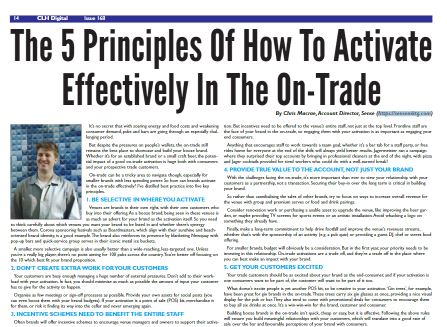The 5 principals of how to activate effectively in the on-trade

By Chris Macrae, Account Director, Sense
It’s no secret that with soaring energy and food costs and weakening consumer demand, pubs and bars are going through an especially challenging period. This makes shopper marketing challenging, requiring more strategic planning to make an impact.
Despite the pressures on people’s wallets, the on-trade still remains the best place to showcase and build your booze brand. Whether it’s for an established brand or a small craft beer, the potential impact of a good on-trade activation is huge both with consumers and your prospective trade customers.
On-trade can be a tricky area to navigate though, especially for smaller brands with less spending power. So, how can brands activate in the on-trade effectively? I’ve distilled best practice into five key principles.
1) Be selective in where you activate
Venues are brands in their own right, with their own customers who buy into their offering. As a booze brand, being seen in these venues is as much an advert for your brand as the activation itself. So, you need to think carefully about which venues you want your brand to be listed in and whether there’s synergy between them. Corona sponsoring festivals such as Boardmasters, which align with their sunshine and beach-oriented brand identity, is a good example. The brand also reinforces its presence by blanketing Newquay with pop-up bars and quick-service group serves in their iconic metal ice buckets.
A smaller, more selective campaign is also usually better than a wide-reaching, less-targeted one. Unless you’re a really big player, there’s no point aiming for 100 pubs across the country. You’re better off focusing on the 10 which best fit your brand proposition.
2) Don’t create extra work for your customers
Your customers are busy enough managing a huge number of external pressures. Don’t add to their workload with your activation. In fact, you should minimise as much as possible the amount of input your customer has to give for the activity to happen.
Organise as few meetings or sign-off processes as possible. Provide your own assets for social posts (you can even boost them with your brand budgets). If your activation is a point of sale (POS) kit, merchandise it for them, or risk it finding its way into the cellar and never emerging again.
3) Incentive schemes need to benefit the entire staff
Often brands will offer incentive schemes to encourage venue managers and owners to support their activation. But incentives need to be offered to the venue’s entire staff, not just at the top level. Frontline staff are the face of your brand in the on-trade, so engaging them with your activation is as important as engaging your end consumers.
Anything that encourages staff to work towards a team goal, whether it’s a bar tab for a staff party, or free rides home for everyone at the end of the shift, will always yield better results. Jagermeister ran a campaign where they surprised their top accounts by bringing in professional cleaners at the end of the night, with pizza and Jager cocktails provided for tired workers who could do with a well-earned break!
4) Provide true value to the account, not just your brand
With the challenges facing the on-trade, it’s more important than ever to view your relationship with your customers as a partnership, not a transaction. Securing their buy-in over the long term is critical in building your brand.
So, rather than cannibalising the sales of other brands, try to focus on ways to increase overall revenue for the venue with group and premium serves or food and drink pairings.
Consider renovation work or purchasing a usable asset to upgrade the venue, like improving the beer garden, or maybe providing TV screens for sports events or an artistic installation. Avoid whacking a logo on something they already have.
Finally, make a long-term commitment to help drive footfall and improve the venue’s revenues streams, whether that’s with the sponsorship of an activity (e.g. a pub quiz) or providing a guest DJ, chef or street food offering.
For smaller brands, budget will obviously be a consideration. But in the first year, your priority needs to be investing in this relationship. On-trade activations are a trade off, and they’re a trade off in the place where you can best make an impact with your brand.
5) Get your customers excited
Your trade customers should be as excited about your brand as the end-consumer, and if your activation is one consumers want to be part of, the customer will want to be part of it too.
What doesn’t excite people is yet another POS kit, so be creative in your activation. ‘Gin trees’, for example, have been great for gin brands in the on-trade. These trees carry six gin glasses at once, providing a nice visual display for the pub or bar. They also tend to come with promotional deals for consumers to encourage them to buy all six drinks at once. It’s a win-win-win for the brand, customer and consumer.
Building booze brands in the on-trade isn’t quick, cheap, or easy, but it is effective. Following the above rules will ensure you build meaningful relationships with your customers, which will translate into a good rate of sale over the bar and favourable perceptions of your brand with consumers.